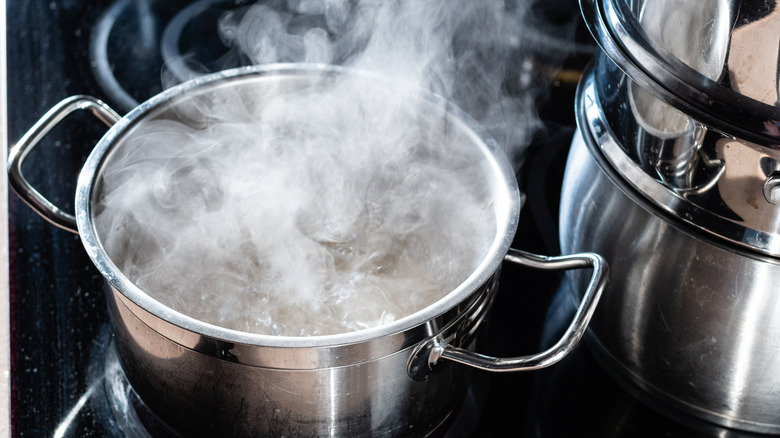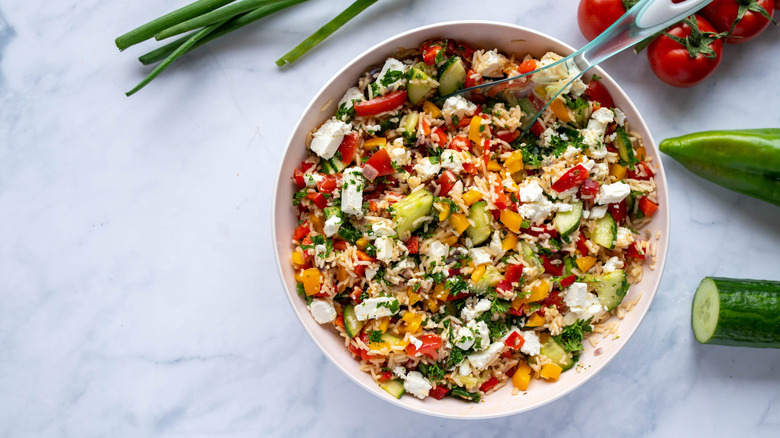The Easiest Way To Cook Grains Perfectly Without Any Measuring
I'll admit, I'm not the best at cooking rice. Like many cooks, I find the supposedly-simple dish tricky to perfect. But there are two rules I learned early on: keep the lid on at all times and measure your water carefully. You'll hear similar advice for other grains, like barley. Neither rule is as unshakeable as I assumed. Lifting the lid to check on your rice to give it a quick flip can help the grains cook smoothly. Treating your grains like pasta (dumping them in a pot with plenty of water and letting them drain at the end) can help demystify the process for the rice-adverse. Just ask blogger Jem Mantiri.
Mantiri is the brains behind The Fruity Jem, where she creates recipes inspired by her Indonesian heritage and her passion for vegan food. "This method is great for beginners or if you're cooking a new grain type or if the cooking instructions are missing from the package," Mantiri told The Takeout. "There is no need to worry about exact ratios or burning the bottom of the pot. You can also control the texture of the cooked grains better this way."
The pasta method is especially useful for large batches. Most rice cookers only hold a few cups, and it's harder to gauge how much water you'll need when you're making a big pot. "It's great when you're cooking for a crowd since this might be easier than trying to accurately measure the amount of water required," Mantiri explained.
How to cook grains like pasta
There's no trick to this method. Just pretend you're making a big pot of orzo and bring a pot of salted water to boil then add your grain to the water. This is one of the few scenarios where you don't need to wash your grains, but you might want to add a splash of vinegar to the water for fluffy, flavorful rice.
Grains tend to cook faster with the pasta method, but the exact amount of time you'll need will depend on the type of grain you're using. White rice takes 10 to 15 minutes, while wild rice takes up to 45 minutes. Millet and brown rice take around half an hour to cook through. If it's your first time cooking a new grain, check in after five minutes — and keep checking. There's no need to worry about lifting the lid since you're not using the steam to help cook the rice.
Drain the grains through a mesh strainer once they're fully cooked. If you're planning to serve them at room temperature, give them a quick rinse in cool water and spread them out on a baking sheet to keep the grains from overcooking and help them dry. If you're planning on serving them warm but still want to dry them out, put them back in the pot and heat them over a low burner until the moisture evaporates. It shouldn't take more than a minute.
When should you use the pasta method to cook grains?
There's a time and a place for everything. Sometimes, dishes specifically call for boiled rice. It's a popular method in Central and Southern Asian recipes, in particular. But sometimes you'll need to measure carefully. For one, there's a practical concern. Before you try the pasta method, remember you'll be constrained by the size of your strainer. "It works great for larger grains such as brown rice, barley, and wild rice," Mantiri says. "This is because larger grains will get strained way better than smaller grains like quinoa."
You'll want to take the final texture of the rice into consideration, too. The pasta method makes for grains with a light, loose texture with fewer clumps or starchy, broken bits. That's perfect for dishes like rice salad, where you mix the rice with other ingredients. A loose texture isn't always ideal, though. Sometimes, you want your rice to be sticky — like, well, if you're making sticky rice. You'll want to follow tradition if you're making soupier dishes, like congee or risotto, too.


